Bharathappuzha
Bharathappuzha ("River of Bhārata"), also known as the Nila, is a river in India in the state of Kerala. With a length of 209 km,[2] It is the longest river of Kerala.The total length of Bharathapuzha is 250 km of which 41 km runs along Tamil Nadu from where it originates. Nila has groomed the culture and life of south Malabar part of Kerala. It is also referred to as "Peraar" in ancient scripts and documents. River Bharathapuzha is an interstate river and lifeline water source for a population residing in four administrative districts, namely Malappuram, Thrissur and Palakkad districts of Kerala and Coimbatore, and Tiruppur of Tamil Nadu.

| Bharathapuzha | |
|---|---|
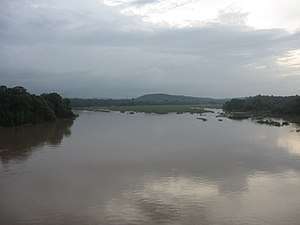 | |
Labelled map of Bharathappuzha | |
| Location | |
| Country | India |
| State | Kerala,Tamilnadu |
| Physical characteristics | |
| Source | Anamalai Hills |
| • location | Tamil Nadu, India |
| • coordinates | 10°36′N 77°07′E |
| • elevation | 2,461 m (8,074 ft) |
| Mouth | Lakshadweep Sea[1] |
• location | Ponnani, Kerala |
• coordinates | 10°47′23.89″N 75°55′17.42″E |
• elevation | 0 m (0 ft) |
| Length | 209[2] km (130 mi) |
| Basin size | 6,186 km2 (2,388 sq mi) |
| Discharge | |
| • location | mouth |
| • average | 161 m3/s (5,700 cu ft/s) |
| Basin features | |
| Tributaries | |
| • left | Thuthapuzha, Gayathripuzha, Kalpathipuzha, Kannadipuzha, Tirur River |
Course

The headwaters of the main tributary of Bharathapuzha originates from various parts of the Western Ghats as small rivulets, and flows westward through Palakkad Gap, (also known as Palghat gap) across Palakkad, Thrissur and Malappuram districts of Kerala, with many tributaries joining it, including the Tirur River. For the first 40 km or so, the Bharathappuzha follows an almost northerly course till Pollachi near Coimbatore. At Parli, the Kannadipuzha and Kalpathipuzha River merge and flow as Bharathappuzha, following a westerly course until it empties into the Lakshadweep Sea at Ponnani.[1] At Mayannur, Gayathripuzha merges with the river. The Thuthapuzha merges with the Nila at Pallippuram. As the Thootha River is rich in water, after its merger, the Nila becomes thicker inflow.
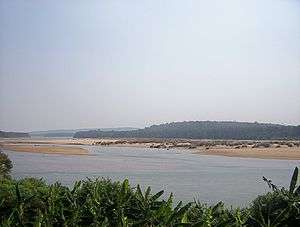

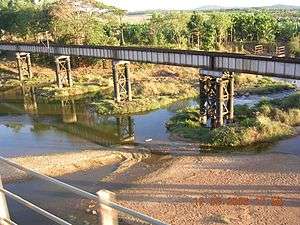
The river is not navigable along most of its course except the small stretch where it joins the sea. With a watershed of 6,186 km2, the Bharathapuzha basin is the largest among all the river basins in Kerala. A little more than two-thirds of this area (4400 km2) is within Kerala and the remaining area (1786 km2) is in Tamil Nadu. Though Bharathapuzha has a large basin, the water flow is relatively less compared to other long rivers in Kerala because a large portion of the basin is located in the comparatively drier regions (Tamil Nadu and Palakkad Gap). The construction of a number of dams after independence has also reduced the river flow. In fact, in the summer months, there is almost no flow in most parts of the river. The Bharathapuzha is the lifeline of many cities and villages: Chittur-Thathamangalam (in Chittur, Bharathappuzha is known as "Sokanasini"; this name was given by Thunjathu Ramanujan Ezhuthachan), Kodumbu-Thiruvalathur, Palakkad, Parli-Kottayi, Mankara-Perigottukurissi, Lakkidi-Thiruvilwamala, Killikkurussimangalam, Ottappalam, Shoranur, Cheruthuruthy, Chelakkara, Pattambi, Thrithala, Thiruvegappura, Kudallur, Pallipuram and Kumbidi. The village of Parudur, including the town of Pallipuram, stands near the confluence of this river and the River Thootha or, simply, Thuthapuzha. Then it goes through Kuttipuram, Tirunavaya, and Ponnani.
Irrigation projects
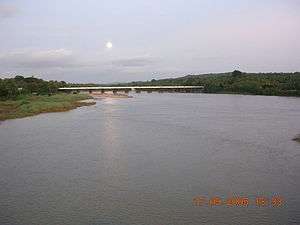
The Bharathappuzha is extensively dammed. There are 11 reservoirs along the course of the river, and two more are under construction. Malampuzha dam is the largest among the reservoirs built across Bharathapuzha and its tributaries. Other dams in the Bharathapuzha basin are Walayar Dam, Mangalam Dam, Pothundi Dam, Meenkara Dam, Chulliyar Dam, Thirumoorthy, Aliyar, Upper Aliyar, Chitturpuzha regulator and Kanjirapuzha Dam. Most of these reservoirs serve the purpose of irrigation only. A total area of 773 km2 is irrigated by these irrigation projects. One irrigation dam at Chittur in Attappadi Hills is under construction. The construction of these two dams will increase the area irrigated by another 542 km2. Another major project is the Regulator cum bridge at Thrithala built on the Velliyankallu bridge. The bridge connects the two villages Pallippuram and Thrithala. The main objective of the regulator is the drinking water supply. The water supply projects towards Thrissur district has already started. The shutter height of the regulator is 5 meters, and it can contain a huge quantity of water. Also, the new bridge reduces the distance from Thrissur to Kozhikode by 11 km. This project is the largest in Bharathappuzha in the last many decades. Fish species once thought to be almost extinct have come back remarkably due to the increased water level during summer. Special note is to be made on the species called 'Vaala' considered to be the king of fresh water fishes. Individual 'Vaala' weighing 5 to 10 kg are now common.
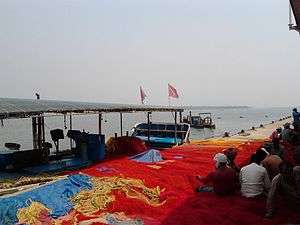
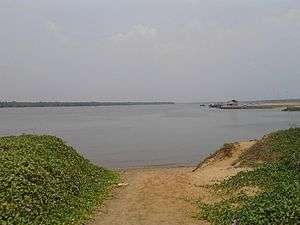
Cultural significance
Bharathappuzha is the lifeline of Kerala's cultural map. Kerala Kalamandalam, which is a major center for learning Indian performing arts like Kathakali, Koodiyattam and Ottamthullal, is situated at Cheruthuruty on the banks of this river—in Thrissur district. The birthplace of famous Malayalam satire poet and founder of the Ottamthullal art form, Kunchan Nambiar, is located at Killikkurissimangalam near Lakkidi, again on the banks of the Nila.Tholpavakoothu (around 65 temples are situated in the banks of river Nila) is a unique shadow puppet play mainly performed in the Bhadar Kali temple in the Malabar region Leading Malayalam writers who were born along its banks include M. T. Vasudevan Nair, M. Govindan, V. K. N., O. V. Vijayan and M. Sukumaran. Late poet P. Kunhiraman Nair, a native of North Malabar, drew literary inspiration from the scenic beauty of the landscape along the Bharatapuzha. There are a number of famous Hindu temples like Thiruvilwamala Temple, Thirunavaya Navamukunda Temple, Chamravattam AyyappaTemple and Panniyur Sri Varahamurthy Temple on the bank of Nila.
Legend says that those cremated on the banks of the Bharathappuzha achieve salvation. It is also one of the important places in the state where the sons pay homage to their late fathers by conducting a Pithru Tharpanam ritual on the Karkidaka Vavu day. Some of the famous persons cremated here include literary personalities like O V Vijayan and VKN.
Degradation
The river went through a series of challenges which saw its degradation that has reached a point of no return. The erratic, non-conservative attitude of people has resulted in much of its water becoming not potable. Until a few decades back, the river used to flow effortlessly during even intense summer. However, due to the sand mining in the last 30 years, the thick sand bed has been completely vanished and has then been replaced with grasses and bushes which has become an environmental catastrophe. At the peak of the sand mining period in the mid 1990s at least 40-50 lorries carrying tonnes of pristine sands were a common sight at each 'kadavu' (entrance to the river) of the river. Considering the hundreds of 'kadavu' throughout its length, the amount of sand mined in these years is unimaginable. Today, with almost no sand in many parts of the river, people have started mining sand from underwater which has become a profitable business for many.. Significant changes in the climatic pattern also altered the flow pattern in the river. Studies reported that there is a significant dip in the total annual rainfall[3] and significant increase in the annual temperature in the basin.[4]
Challenges
The river now faces significant challenges for its survival. It is predicted that the river may change its course due to the obstruction of the tall grasses and bushes that has grown in the river. Illegal sand mining mafias are very active and the nexus between the politicians, bureaucrats and these mafias make it extremely difficult to stop this. Organisations which were once very active have now gone on hibernation due to the threat posed by them. Environmentalists have predicted dire consequences and the untimely death of the river within the near future. The wastes from the hospitals and other sources pollute the water.
Social networking sites like Facebook have active groups with a purpose of saving the river named as Bharathappuzha Samrakhshana Samithi.[5]
Friends of Bharathapuzha, a nature lovers’ collective, is being formed with the objective of strengthening and protecting the Bharathapuzha. It is lead by E.M. Sreedharan, veteran engineer popularly known as 'Metroman'.[6]
Actions required for saving the river
Environmentalists suggest the followings actions for saving the river.
- Controlled mining of the sand if not completely stopping it. Sand beds which got created in millions of years were completely removed within a few years of human greed and mismanagement. Creation of sand is a very slow process and is considered as the veins of the river. Although a total ban is impossible and impracticable, strict regulations needs to be put in place for sustainable mining of sand. Experts suggest that a portion of the revenue from sand mining has to be allocated for river management.
- Strict regulations for hotels, hospitals and households on managing their waste. Regulation has to be put in place and enforced for managing waste generated by hospitals and hotels.
- Planting trees like Banyan, Jackfruit, Teak, or Mango can enhance the water table and the water quality as these trees can hold large amount of water in its roots and will slowly discharge it during summer. This method has found to be successful in many parts of the world in reviving rivers.
- Planting and growing mangroves wherever possible: Mangroves acts a barrier protecting the river banks from soil erosion. The ecosystem within the mangroves are varied and complex and help aquatic species to thrive in rivers.
- Constructing check dams: Check dams slow down the flow of the river where by recharging the ground water and increasing the water table.
Tributaries

Sorted in order from the mouth heading upstream.
Notes
- "A CHECKLIST OF AVIFAUNA OF THE BHARATHAPUZHA RIVER BASIN, america" (PDF). Zoo Outreach Organisation. Retrieved 24 April 2014.
- "Bharathapuzha is dry much ahead of summer". The Hindu. Retrieved 24 August 2018.
- Raj, P.P.Nikhil; azeez, P.A (2012). "Trend analysis of rainfall in Bharathapuzha River basin, Kerala, India". International Journal of Climatology. 32 (4): 533–539. doi:10.1002/joc.2283.
- Raj, P.P.Nikhil; Azeez, P.A (2011). "Temperature rise in the Bharathapuzha river basin, southern India". Current Science. 101 (4): 492.
- http://www.facebook.com/groups/bhaarathapuzha/
- Naha, Abdul Latheef (10 July 2019). "'Metroman' E. Sreedharan to turn 'Riverman' to help protect Bharathapuzha". The Hindu. Retrieved 18 January 2020.
References
- https://www.youtube.com/watch?v=DGdKcAbPZ_c
- https://www.youtube.com/watch?v=gEoV4xhJHBM
- https://www.youtube.com/watch?v=R6eA7wahVDY
- https://www.youtube.com/watch?v=07Dxuhs1zLU
- https://www.youtube.com/watch?v=Tb-O2XpGTTE
- Abraham, Vinu (2004), "The way to the Maker", The Week, archived from the original on 24 February 2005, retrieved 10 February 2006 .
- Newindpress (2005), "Thousands offer Pithru Tharpanam", The New Indian Express, archived from the original on 29 September 2007, retrieved 10 February 2006.
- "Infobox facts". All Kerala River Protection Council. Retrieved 30 January 2006.
External links
| Wikimedia Commons has media related to Bharathappuzha. |